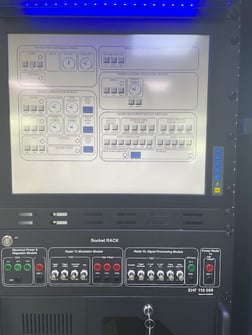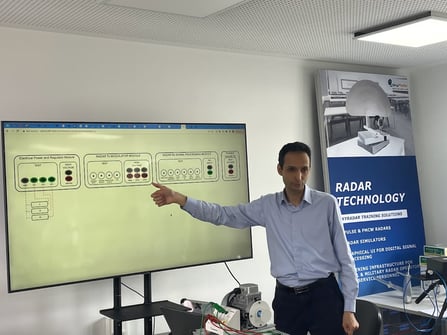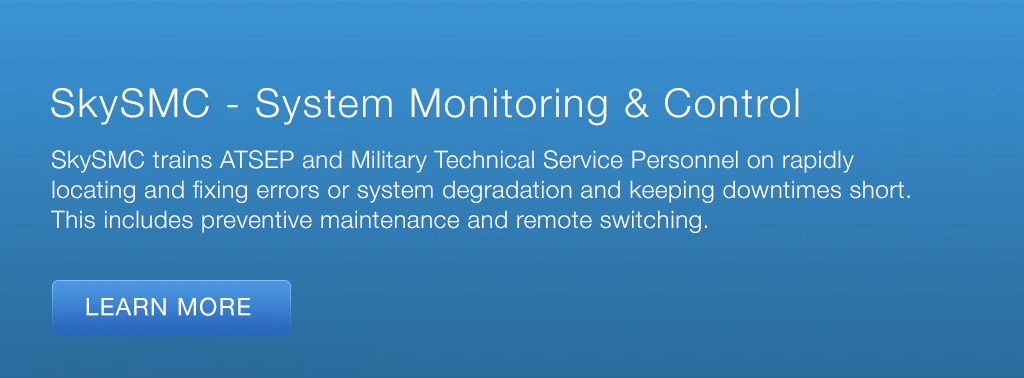Air Traffic Control (ATC) is a crucial component of the aviation industry as it ensures safe and efficient air travel. One of the key elements of ATC is the communication system between air traffic controllers and pilots, which relies heavily on radio transmission.
However, transmitter errors due to synchronization with the receiver can significantly impact the reliability and safety of this communication system. In this article, we will explore the definition, types, causes, and impact of transmitter errors due to synchronization with the receiver in ATC, along with steps to rectify and prevent these errors.
Definition of Transmitter Errors due to Synchronization Issues with the Receiver
Transmitter errors due to synchronization issues with the receiver refer to a situation where the transmitter and receiver are not operating at the same frequency or phase, leading to issues with the accuracy and reliability of the communication system. In other words, synchronization errors occur when the receiver and transmitter are not in harmony with each other, leading to a mismatch in the signals transmitted and received.
What is Synchronization with the Receiver?
Synchronization with the receiver refers to the ability of the transmitter and receiver to operate at the same frequency and phase. In a communication system, synchronization ensures that the transmitted signal is accurately received by the receiver, enabling clear and uninterrupted communication. The synchronization process involves the transmitter and receiver matching their frequencies and phases to ensure that the transmitted signal is accurately received. For instance, in the case of ATC, air traffic controllers and pilots rely on synchronization between their radios to communicate effectively and ensure safe flight operations.
Factors Responsible for Synchronization Issues with the Receiver related Transmitter Errors
Several factors can lead to synchronization-related transmitter errors, including:
Equipment Malfunction
Malfunctioning or damaged equipment can cause synchronization issues between the transmitter and receiver.
Operator Error
Improper use or configuration of the transmitter or receiver can result in synchronization errors.
Interference
External sources of interference, such as other communication signals or electromagnetic radiation, can cause synchronization errors.
Frequency Drift
Over time, the frequency of the transmitter and receiver can drift, causing synchronization errors.
Some common types of Transmitter Errors caused by Synchronization Issues with the Receiver
Some common types of transmitter errors caused by synchronization with the receiver include
Frequency Drift
Over time, the frequency of the transmitter and receiver can drift, leading to synchronization errors.
Interference
External sources of interference, such as other communication signals or electromagnetic radiation, can cause synchronization errors.
Faulty Equipment
Malfunctioning or damaged equipment can cause synchronization issues between the transmitter and receiver.
Scenario illustrating the impact of Transmitter errors related to Synchronization Issues with the Receiver on ATC services
Scenario 1: Delayed Transmission of Aircraft Data
In an air traffic control center, a transmitter error occurs, resulting in delayed transmission of aircraft data to the receiver. The transmitter is responsible for sending vital information such as aircraft identification, position, and speed to the receiver, which air traffic controllers rely on for effective traffic management. Here is how this scenario can impact air traffic control services:
Increased Response Time
The delayed transmission of aircraft data from the transmitter to the receiver causes a lag in the information reaching the air traffic controllers. This increases the response time for controllers to make informed decisions and issue instructions to pilots. The delayed data can result in slower aircraft sequencing, increased separation distances, and potential disruptions to the flow of air traffic.
Reduced Situational Awareness
The delay in receiving real-time data from the transmitter impairs the situational awareness of air traffic controllers. They heavily rely on up-to-date information to monitor the positions and movements of aircraft within their airspace. The lack of synchronized data can lead to incomplete or outdated situational awareness, making it challenging to maintain safe separation and make accurate traffic management decisions.
Scenario 2: Inconsistent Transmission of Flight Instructions
In another scenario, a transmitter error causes inconsistent transmission of flight instructions to the receiver. Air traffic controllers use the transmitter to send instructions, such as altitude changes or route modifications, to pilots. However, due to the synchronization error, the instructions may be received inconsistently or with errors. Here are the impacts of this scenario:
Miscommunication and Confusion
Inconsistent transmission of flight instructions leads to miscommunication and confusion between air traffic controllers and pilots. Pilots may receive conflicting or incomplete instructions, which can lead to uncertainty about the correct course of action. Misinterpretation of instructions can result in deviations from assigned routes, potential conflicts with other aircraft, or compromised safety.
Decreased Compliance
Inaccurate or inconsistent transmission of flight instructions can lead to decreased compliance from pilots. If pilots receive unclear or contradictory instructions, they may hesitate or make decisions based on incomplete information. This can disrupt the smooth flow of air traffic and increase the risk of incidents such as loss of separation or runway incursions.
Increased Workload for Controllers
The transmitter error puts additional workload on air traffic controllers. They need to closely monitor the consistency and accuracy of instructions received by pilots and quickly address any discrepancies or errors. This increased workload can lead to mental fatigue, decreased situational awareness, and potential errors in managing air traffic.
These scenarios illustrate the impact of transmitter errors related to synchronization with the receiver on air traffic control services. Delayed transmission of aircraft data and inconsistent transmission of flight instructions can lead to inefficiencies, miscommunication, and compromised safety within the air traffic control system. It emphasizes the need for robust and reliable transmitter systems, regular maintenance, and effective synchronization mechanisms to ensure accurate and timely information exchange between air traffic controllers and pilots.
Impact of Synchronization Error related to Radar Receiver on Air Traffic Control Services
Synchronization errors related to radar receiver systems can have a significant impact on air traffic control (ATC) services. Here are some key impacts:
Inaccurate Position Reporting
Synchronization errors can lead to inaccuracies in position reporting of aircraft on radar displays. The timing discrepancies can cause delays in updating aircraft positions, resulting in incorrect or outdated information being presented to air traffic controllers. This can hinder situational awareness and decision-making, potentially compromising the safety and efficiency of air traffic control services.
Tracking Errors
Synchronization errors can affect the accuracy of tracking targets, including aircraft, on the radar display. Inconsistent timing can lead to deviations in target positions and trajectories, making it challenging to maintain reliable track data. This can impact the ability to accurately predict aircraft movements, detect conflicts, and provide timely guidance to pilots.
Reduced Surveillance Coverage
Synchronization errors can result in degraded surveillance coverage. Incomplete or delayed updates of radar data due to timing discrepancies may lead to gaps in radar coverage. This can result in reduced radar coverage for certain areas, increasing the risk of undetected aircraft or limited visibility of air traffic movements.
False Alarms and Ghost Targets
Synchronization errors can introduce false alarms and ghost targets on the radar display. Timing inconsistencies can cause spurious returns or reflections, leading to the detection of non-existent targets or misinterpretation of radar echoes. False alarms and ghost targets can create confusion and unnecessary workload for air traffic controllers, diverting their attention from actual aircraft.
Loss of Data Integrity
Synchronization errors can compromise the integrity of radar data. Inaccurate timing can affect data transmission and reception, leading to corrupted or incomplete radar data. This can result in missing or unreliable information, hindering the ability to accurately assess the airspace, detect potential conflicts, and provide timely guidance to pilots.
Increased Controller Workload
Synchronization errors can increase the workload for air traffic controllers. Dealing with inaccurate or delayed radar data requires additional effort and attention from controllers to interpret and validate the information. This can lead to increased mental workload and potential fatigue, potentially affecting decision-making and overall operational efficiency.
Safety Risks
The impact of synchronization errors on ATC services can introduce safety risks. Inaccurate position reporting, tracking errors, and compromised surveillance coverage can undermine the ability to ensure safe separation between aircraft. This increases the risk of potential conflicts, loss of separation, and incidents or accidents in the airspace.
Steps to be taken by ATSEP in Rectification of Transmitter Errors related to Synchronization with the Receiver
To rectify transmitter errors related to synchronization with the receiver, ATSEP should take the following steps
Diagnose the problem
ATSEP should investigate the issue to identify the cause of the error. This involves performing tests to determine whether the problem is due to equipment malfunction, interference, or other factors.
Isolate the source of the error
Once the cause of the error has been identified, ATSEP should isolate the source of the problem. For instance, if the issue is due to interference, the ATSEP should locate the source of the interference and take appropriate steps to mitigate it.
Repair or replace faulty equipment
If the error is due to equipment malfunction, the faulty equipment should be repaired or replaced as soon as possible to prevent further errors.
Verify that the problem has been resolved
After repairs have been made, ATSEP should verify that the issue has been resolved. This involves performing tests to ensure that the system is functioning correctly.
Steps to be followed by ATSEP for preventing Synchronization with the Receiver related Transmitter Errors
Regular maintenance
ATSEP should perform regular maintenance on the equipment to ensure that it is functioning correctly.
Upgrades and updates
ATSEP should ensure that the equipment is up to date with the latest upgrades and updates.
Interference mitigation
ATSEP should take appropriate measures to mitigate interference, such as using appropriate shielding and filtering techniques.
Proper training
Operators should be properly trained to ensure that they are using the equipment correctly and that they understand how to identify and resolve issues.
How to prevent errors due to Synchronization with the Receiver:
To prevent errors related to synchronization with the receiver, ATSEP should take the following steps
Use quality equipment
High-quality equipment is less likely to malfunction and is less susceptible to interference.
Proper installation
Equipment should be properly installed and configured to ensure that it is functioning correctly.
Regular maintenance
Regular maintenance can help to identify and prevent issues before they become major problems.
Interference mitigation
Appropriate measures should be taken to mitigate interference, such as using appropriate shielding and filtering techniques.
Research Highlights
Timing and Phase Errors
Synchronization between the transmitter and receiver relies on accurate timing and phase alignment. Research has focused on addressing timing errors, such as clock drift, jitter, and synchronization delays, that can occur in the transmitter. By developing precise timing synchronization techniques and phase-locked loops, researchers aim to minimize these errors and ensure reliable synchronization with the receiver.
Frequency Offset Compensation
Frequency offsets between the transmitter and receiver can lead to synchronization errors. Research has explored methods to estimate and compensate for frequency offsets, including carrier frequency recovery algorithms and adaptive frequency tracking techniques. These approaches aim to improve the accuracy of synchronization and mitigate the impact of frequency discrepancies.
Symbol Timing Recovery
Symbol timing recovery is crucial for correct demodulation and decoding of the received signal. Research has focused on developing robust symbol timing recovery algorithms that can handle timing errors and variations caused by transmitter imperfections or channel effects. These algorithms aim to synchronize the receiver's sampling clock with the transmitter's symbol timing to ensure accurate signal reception.
Phase Noise and Distortion Mitigation
Transmitters can introduce phase noise and distortion to the transmitted signal, which can affect synchronization at the receiver. Research has investigated techniques to mitigate the impact of phase noise and distortion, including adaptive equalization, digital pre-distortion, and advanced modulation schemes. These methods aim to enhance synchronization by reducing the effects of transmitter-induced impairments.
Channel Estimation and Equalization
Synchronization errors can also arise from imperfect channel estimation and equalization at the transmitter. Research has focused on developing channel estimation algorithms that accurately estimate channel characteristics, such as fading, multipath propagation, and interference. Additionally, advanced equalization techniques, such as adaptive equalization and decision-feedback equalization, aim to compensate for channel distortions and improve synchronization performance.
System-Level Synchronization
In some cases, synchronization errors may arise due to system-level issues rather than specific transmitter errors. Research has explored synchronization architectures and protocols that enable efficient synchronization across multiple transmitters and receivers in complex communication systems. These studies aim to ensure synchronization coordination and alignment in multi-user and multi-antenna systems.
SkyRadar's System Monitoring & Control Solution
SkySMC - SkyRadar’s System Monitoring and Control Suite is a pedagogically enhanced, fully operational monitoring & control tool. It has been designed to practice these use cases. We have optimized it to host ATSEP training in SUR, NAV, COM, DPR and SMC compliant to EASA's Easy Access Rules for ATM-ANS (Regulation (EU) 2017/373) and ICAO Doc 10057.
SkyRadar provides SkySMC as a complete laboratory in a turn-key approach, or as a virtual infrastructure (for purchase or as a service).
SkySMC is not a simulator, but a fully operational open monitoring system. It comes by default with a server including various virtualized applications and virtualized servers, but also connects to simulated systems. In addition, there are various hardware extensions available including training infrastructures, monitorable training radars, or even complete ATM systems, all connected to the System Monitoring & Control solution. Most components such as the radars, it IT infrastructure or networks exist in hardware and software (virtualized or simulated).
The two photos above show the same trouble-shooting panel and socket rack in real hardware and in the simulator (fully functioning).
SkyRadar's System Monitoring & Control training system can be easily blended into distance learning solutions and existing learning management systems.
Let's talk
Stay tuned to be always the first to learn about new use cases and training solutions in ATSEP qualification (real radars or simulators).
Or simply talk to us to discuss your training solution.
References
- FAA Order 7900.5, Safety Management System Policy
- FAA Advisory Circular 00-45H, Aviation Weather Services
- ICAO Annex 10, Aeronautical Telecommunications, Volume II - Communication Procedures
- "ATC Communications Errors: Why They Occur and How to Prevent Them." Air Traffic Control Quarterly, vol. 23, no. 4, 2015, pp. 351-358.






